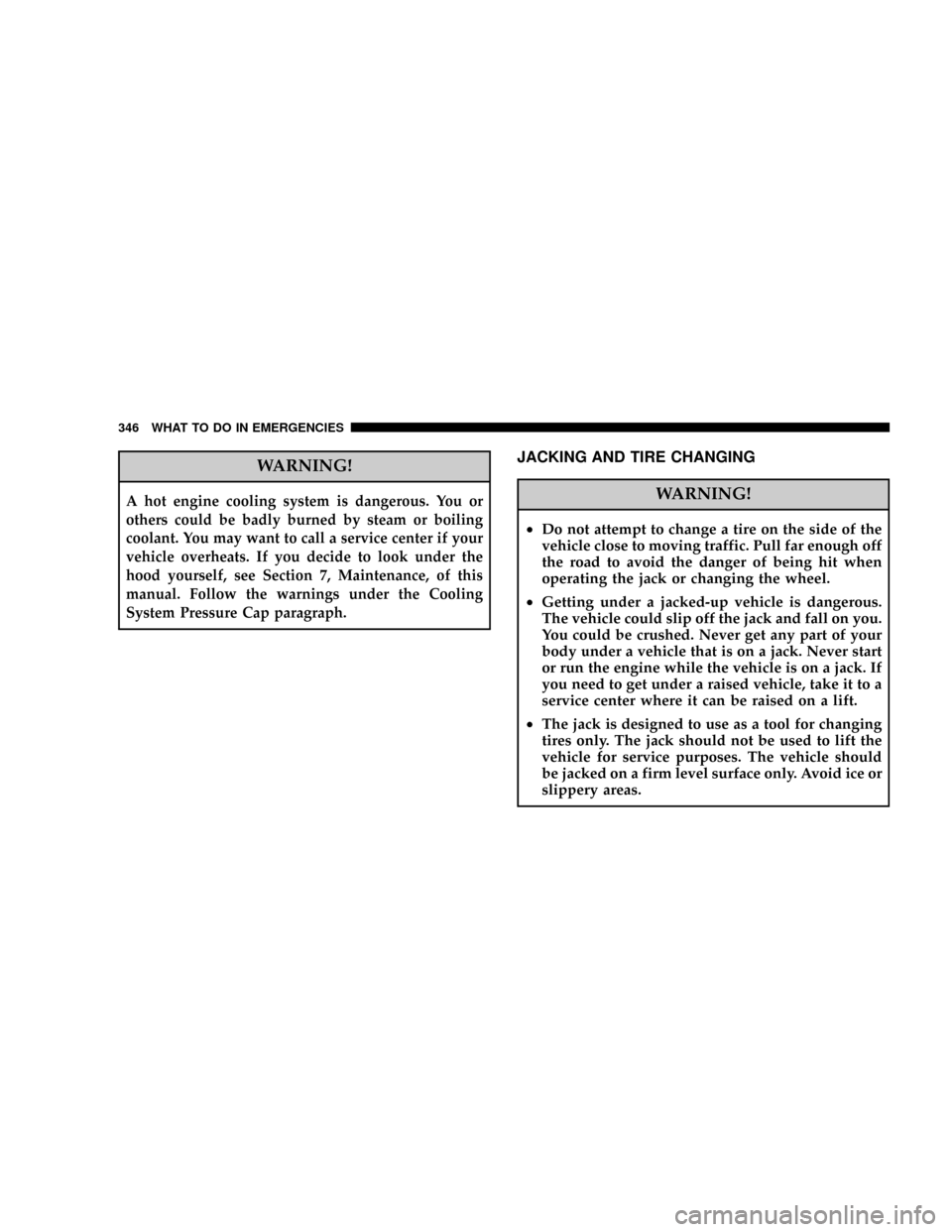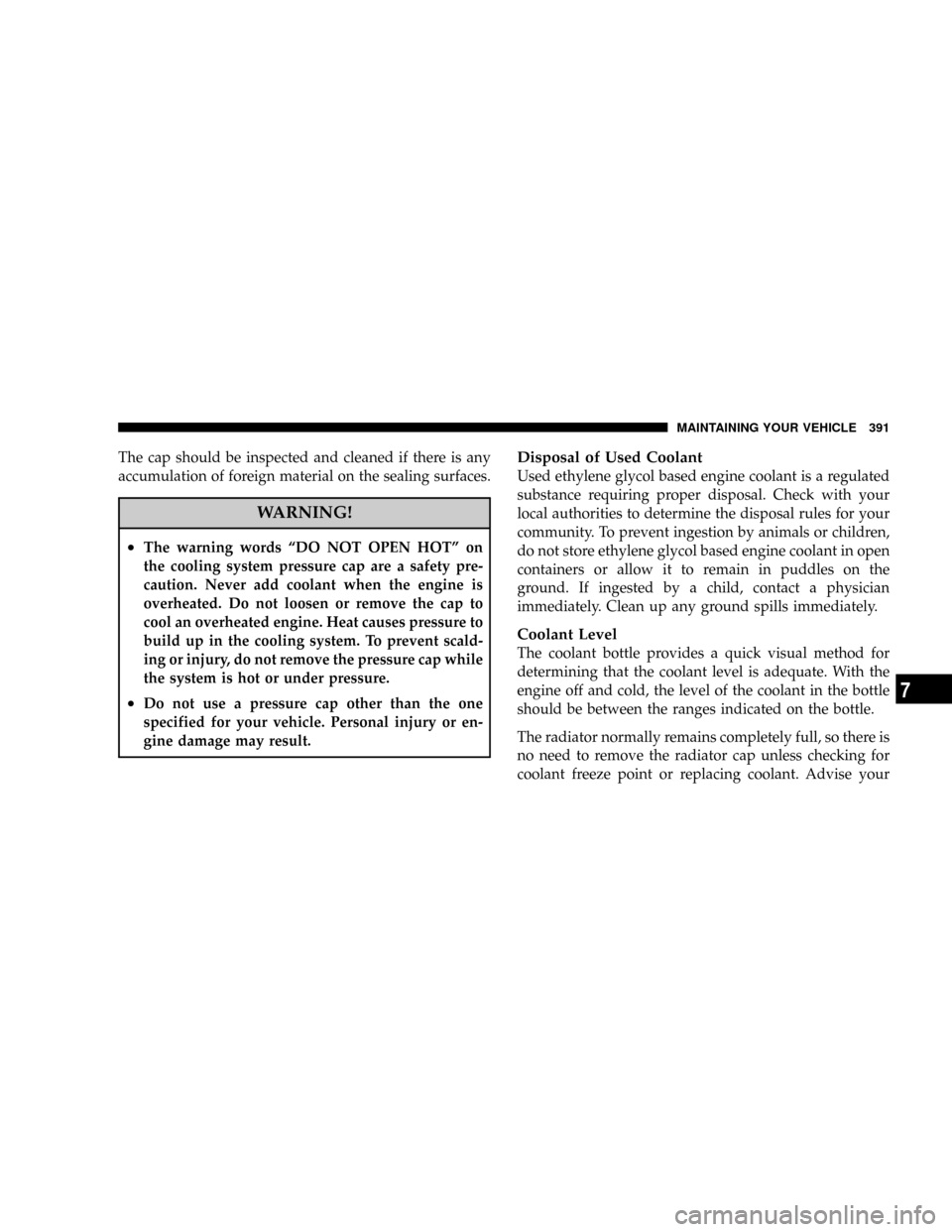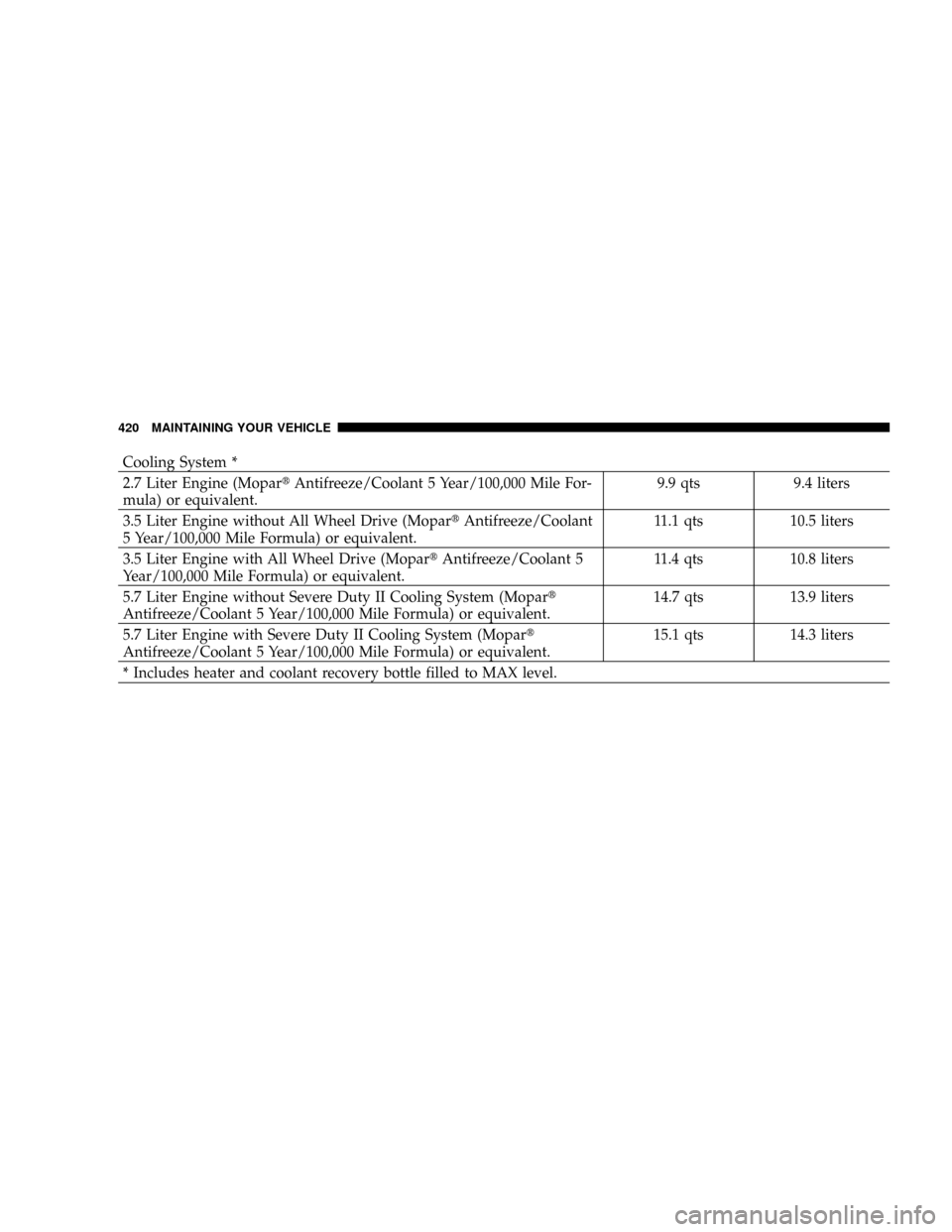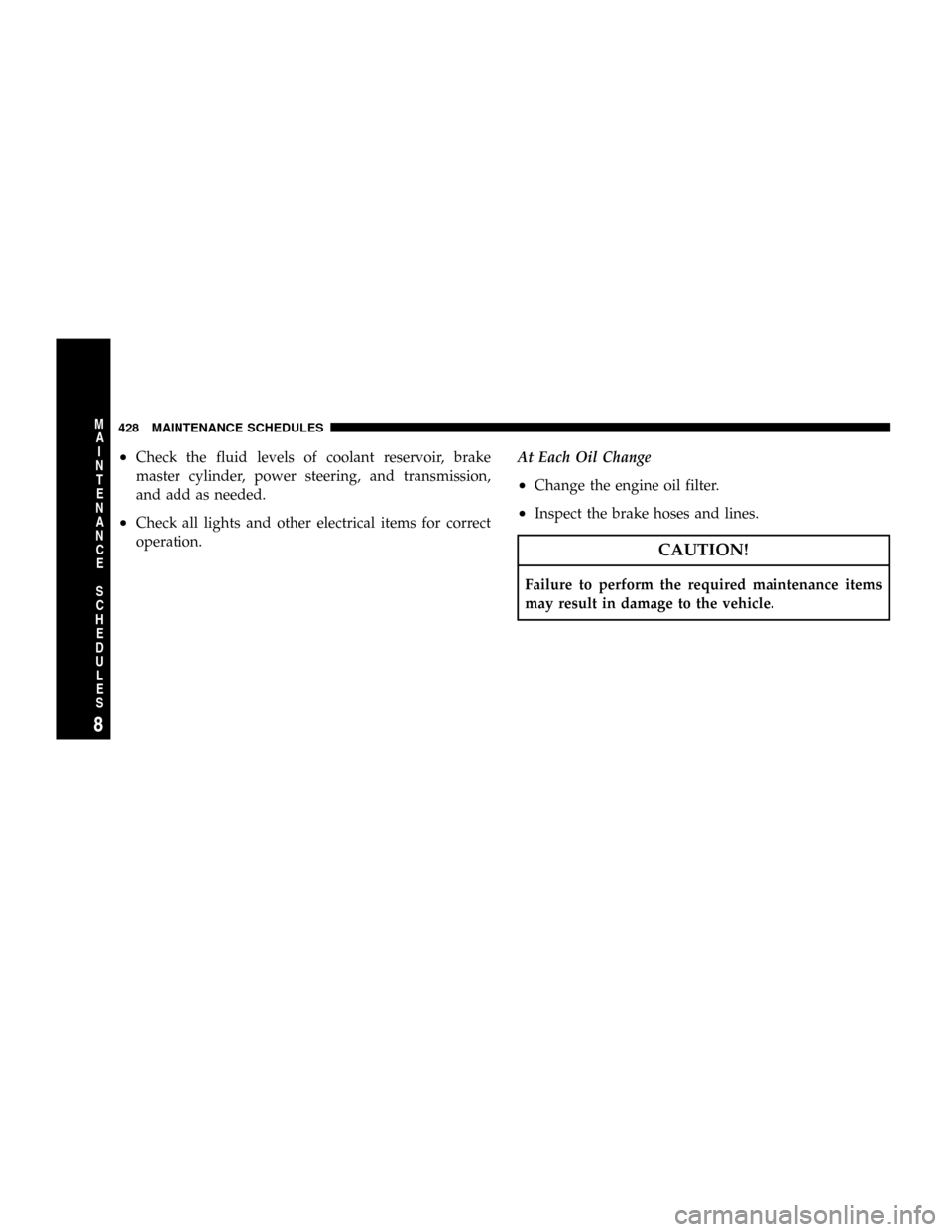coolant level DODGE CHARGER 2008 6.G Owners Manual
[x] Cancel search | Manufacturer: DODGE, Model Year: 2008, Model line: CHARGER, Model: DODGE CHARGER 2008 6.GPages: 466, PDF Size: 6.37 MB
Page 346 of 466

WARNING!
A hot engine cooling system is dangerous. You or
others could be badly burned by steam or boiling
coolant. You may want to call a service center if your
vehicle overheats. If you decide to look under the
hood yourself, see Section 7, Maintenance, of this
manual. Follow the warnings under the Cooling
System Pressure Cap paragraph.
JACKING AND TIRE CHANGING
WARNING!
²Do not attempt to change a tire on the side of the
vehicle close to moving traffic. Pull far enough off
the road to avoid the danger of being hit when
operating the jack or changing the wheel.
²Getting under a jacked-up vehicle is dangerous.
The vehicle could slip off the jack and fall on you.
You could be crushed. Never get any part of your
body under a vehicle that is on a jack. Never start
or run the engine while the vehicle is on a jack. If
you need to get under a raised vehicle, take it to a
service center where it can be raised on a lift.
²The jack is designed to use as a tool for changing
tires only. The jack should not be used to lift the
vehicle for service purposes. The vehicle should
be jacked on a firm level surface only. Avoid ice or
slippery areas.
346 WHAT TO DO IN EMERGENCIES
Page 390 of 466

Adding Coolant
Your vehicle has been built with an improved engine
coolant that allows extended maintenance intervals. This
coolant can be used up to 5 Years or 100,000 miles (160
000 km) before replacement. To prevent reducing this
extended maintenance period, it is important that you
use the same coolant throughout the life of your vehicle.
Please review these recommendations for using Hybrid
Organic Additive Technology (HOAT) coolant.
When adding coolant:
²The manufacturer recommends using Mopart
Antifreeze/Coolant 5 Year/100,000 Mile Formula
HOAT (Hybrid Organic Additive Technology).
²Mix a minimum solution of 50% HOAT engine coolant
and distilled water. Use higher concentrations (not to
exceed 70%) if temperatures below234ÉF (237ÉC) are
anticipated.
²Use only high purity water such as distilled or deion-
ized water when mixing the water/engine coolant
solution. The use of lower quality water will reduce
the amount of corrosion protection in the engine
cooling system.
Please note that it is the owner's responsibility to main-
tain the proper level of protection against freezing ac-
cording to the temperatures occurring in the area where
the vehicle is operated.
NOTE:Mixing coolant types will decrease the life of the
engine coolant and will require more frequent coolant
changes.
Cooling System Pressure Cap
The cap must be fully tightened to prevent loss of
coolant, and to insure that coolant will return to the
radiator from the coolant recovery bottle.
390 MAINTAINING YOUR VEHICLE
Page 391 of 466

The cap should be inspected and cleaned if there is any
accumulation of foreign material on the sealing surfaces.
WARNING!
²The warning words ªDO NOT OPEN HOTº on
the cooling system pressure cap are a safety pre-
caution. Never add coolant when the engine is
overheated. Do not loosen or remove the cap to
cool an overheated engine. Heat causes pressure to
build up in the cooling system. To prevent scald-
ing or injury, do not remove the pressure cap while
the system is hot or under pressure.
²Do not use a pressure cap other than the one
specified for your vehicle. Personal injury or en-
gine damage may result.
Disposal of Used Coolant
Used ethylene glycol based engine coolant is a regulated
substance requiring proper disposal. Check with your
local authorities to determine the disposal rules for your
community. To prevent ingestion by animals or children,
do not store ethylene glycol based engine coolant in open
containers or allow it to remain in puddles on the
ground. If ingested by a child, contact a physician
immediately. Clean up any ground spills immediately.
Coolant Level
The coolant bottle provides a quick visual method for
determining that the coolant level is adequate. With the
engine off and cold, the level of the coolant in the bottle
should be between the ranges indicated on the bottle.
The radiator normally remains completely full, so there is
no need to remove the radiator cap unless checking for
coolant freeze point or replacing coolant. Advise your
MAINTAINING YOUR VEHICLE 391
7
Page 392 of 466

service attendant of this. As long as the engine operating
temperature is satisfactory, the coolant bottle need only
be checked once a month.
When additional coolant is needed to maintain the
proper level, it should be added to the coolant bottle. Do
not overfill.
Points To Remember
NOTE:When the vehicle is stopped after a few miles
(kilometers) of operation, you may observe vapor coming
from the front of the engine compartment. This is nor-
mally a result of moisture from rain, snow, or high
humidity accumulating on the radiator and being vapor-
ized when the thermostat opens, allowing hot coolant to
enter the radiator.
If an examination of your engine compartment shows no
evidence of radiator or hose leaks, the vehicle may be
safely driven. The vapor will soon dissipate.
²Do not overfill the coolant recovery bottle.
²Check coolant freeze point in the radiator and in the
coolant recovery bottle. If antifreeze needs to be
added, contents of coolant recovery bottle must also be
protected against freezing.
²If frequent coolant additions are required, or if the
level in the coolant recovery bottle does not drop when
the engine cools, the cooling system should be pres-
sure tested for leaks.
²Maintain coolant concentration at 50% HOAT engine
coolant (minimum) and distilled water for proper
corrosion protection of your engine, which contains
aluminum components.
²Make sure that the radiator and coolant recovery
bottle overflow hoses are not kinked or obstructed.
392 MAINTAINING YOUR VEHICLE
Page 420 of 466

Cooling System *
2.7 Liter Engine (MopartAntifreeze/Coolant 5 Year/100,000 Mile For-
mula) or equivalent.9.9 qts 9.4 liters
3.5 Liter Engine without All Wheel Drive (MopartAntifreeze/Coolant
5 Year/100,000 Mile Formula) or equivalent.11.1 qts 10.5 liters
3.5 Liter Engine with All Wheel Drive (MopartAntifreeze/Coolant 5
Year/100,000 Mile Formula) or equivalent.11.4 qts 10.8 liters
5.7 Liter Engine without Severe Duty II Cooling System (Mopart
Antifreeze/Coolant 5 Year/100,000 Mile Formula) or equivalent.14.7 qts 13.9 liters
5.7 Liter Engine with Severe Duty II Cooling System (Mopart
Antifreeze/Coolant 5 Year/100,000 Mile Formula) or equivalent.15.1 qts 14.3 liters
* Includes heater and coolant recovery bottle filled to MAX level.
420 MAINTAINING YOUR VEHICLE
Page 428 of 466

²Check the fluid levels of coolant reservoir, brake
master cylinder, power steering, and transmission,
and add as needed.
²Check all lights and other electrical items for correct
operation.At Each Oil Change
²Change the engine oil filter.
²Inspect the brake hoses and lines.
CAUTION!
Failure to perform the required maintenance items
may result in damage to the vehicle.
428 MAINTENANCE SCHEDULES
8
M
A
I
N
T
E
N
A
N
C
E
S
C
H
E
D
U
L
E
S
Page 447 of 466

Checks, Safety........................... 75
Child Restraint..................65,66,67,70,72
Child Restraint Tether Anchors.............68,70
Child Safety Locks........................ 32
Clean Air Gasoline....................... 320
Cleaning
Wheels............................. 401
Windshield Wiper Blades................. 386
Climate Control......................... 239
Clock........................192,196,211,215
Coin Holder........................... 153
Cold Weather Operation................... 256
Compact Disc (CD) Maintenance............. 238
Compact Spare Tire...................... 302
Compass.............................. 181
Compass Calibration..................... 182
Compass Variance....................... 182
Computer, Trip/Travel.................... 178Connector
UCI ................................ 232
Universal Consumer Interface (UCI)......... 232
Conserving Fuel........................ 178
Console, Floor.......................... 153
Console, Overhead....................... 138
Contract, Service........................ 436
Converter, Catalytic...................... 380
Coolant Pressure Cap (Radiator Cap).......... 390
Cooling System......................... 388
Adding Coolant (Antifreeze).............. 390
Coolant Capacity...................... 419
Coolant Level......................388,391
Disposal of Used Coolant................ 391
Drain, Flush, and Refill.................. 389
Inspection........................... 391
Points to Remember.................... 392
Pressure Cap......................... 390
Radiator Cap......................... 390
INDEX 447
10
Page 449 of 466

Electrical Power Outlets................... 149
Electronic Brake Control System
Brake Assist System.................... 285
Electronic Stability Program............... 286
Traction Control System................. 284
Electronic Power Distribution Center (Fuses).... 404
Electronic Speed Control (Cruise Control)...... 135
Electronic Stability Program (ESP)............ 286
Electronic Throttle Control Warning Light...... 165
Electronic Vehicle Information Center (EVIC).... 175
Emergency Deck Lid Release................ 40
Emergency, In Case of
Freeing Vehicle When Stuck............... 359
Hazard Warning Flasher................. 344
Jacking............................. 346
Jump Starting......................... 356
Overheating.......................... 345
Towing............................. 360
Emergency Trunk Release................... 40Emission Control System Maintenance......371,426
Engine.....................74,366,367,368,369
Air Cleaner.......................... 379
Block Heater......................... 258
Break-In Recommendations................ 74
Checking Oil Level..................374,375
Compartment................366,367,368,369
Coolant (Antifreeze).................388,421
Cooling............................. 388
Exhaust Gas Caution..................75,322
Fails to Start.......................... 257
Flooded, Starting...................... 257
Fuel Requirements..................... 319
Jump Starting......................... 356
Multi-Displacement..................... 283
Oil ...........................374,419,421
Oil Change Interval...............169,178,376
Oil Filler Cap......................376,377
Oil Filter............................ 378
INDEX 449
10